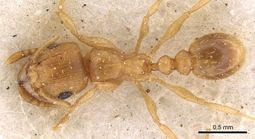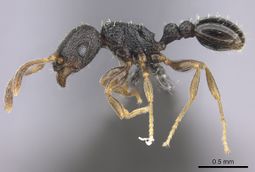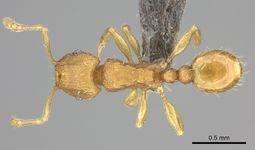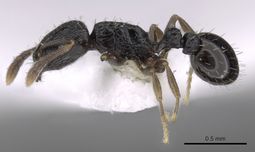Key to Afrotropical Tetramorium simillimum species group
This worker key is based on Bolton (1980)[1]
You may also be interested in
- Tetramorium
- Afrotropical Tetramorium species groups
- Key to Afrotropical Tetramorium species groups
- Group Diagnosis
NOTE: Four species were not included in the original key:
- Tetramorium incruentatum was originally included under Triglyphothrix, and not in the 1980 revisionary work
- Tetramorium intextum and Tetramorium zambezium were considered a synonyms of Tetramorium delagoense and are not included in the original key. They have been added later on.
- Tetramorium pauper is keyed under the shiloense group due to its small eyes
1
- Eyes relatively large, maximum diameter 0.29 x HW at least, usually greater, and longest row of facets in the eye containing 10 or more ommatidia. Ventral surface of head behind buccal cavity commonly with 2-4 elongate hooked or "J"-shaped hairs . . . . . 2
- Eyes relatively smaller, maximum diameter 0,27 x HW at most, usually less, and longest row of facets in the eye containing 7-8 ommatidia at maximum. Ventral surface of head behind buccal cavity without elongate hooked or"J"-shaped hairs . . . . . 7
2
return to couplet #1
- Uniform pale yellow species . . . . . 3
- Uniform very dark brown or black species . . . . . 4
3
return to couplet #2
- Propodeum armed with a pair of broad blunt triangular teeth. Ground-sculpture of head between the rugulae feeble, the surfaces glossy. Petiole node in dorsal view transverse, much broader than long...... Tetramorium luteolum
- Propodeum bluntly angular, without projecting teeth. Ground-sculpture of head between the rugulae a very distinct fine reticulate-punctulation, the surfaces matt and dull. Petiole node in dorsal view about as broad as long..... Tetramorium berbiculum
4
return to couplet #2
- Base of first gastral tergite with a band of shagreening or of reticulate-punctate sculpture . . . . . 5
- Base of first gastral tergite unsculptured except for hair pits . . . . . 6
5
return to couplet #4
- Eyes very large and set well forward on the head, their maximum diameter 0.37-0.39 x HW. In profile the maximum diameter of the eye more than 3 times greater than the distance separating the anterior margin of the eye from the mandibular insertion at their closest approach ..... Tetramorium oculatum
- Eyes much smaller and set at about the midlength of the head, their maximum diameter 0.29-0.32 x HW. In profile the maximum diameter of the eye about equal to the distance separating the anterior margin of the eye from the mandibular insertion at their closest approach..... Tetramorium argenteopilosum
6
return to couplet #4
- Antennal scapes longer, SI 80-87. Metapleural lobes triangular and acute..... Tetramorium bevisi
- Antennal scapes shorter, SI 71. Metapleural lobes bluntly rounded..... Tetramorium krynitum
7
return to couplet #1
- Frontal carinae long and strongly developed throughout their length, running unbroken almost to the occipital margin and forming the dorsal borders of the broad and distinctive antennal scrobes; the carinae always more strongly developed than the remaining cephalic sculpture . . . . . 8
- Frontal carinae feeble or reduced, either fading out posteriorly or uniformly weak, sometimes broken or interrupted and usually not more strongly developed than the remaining cephalic sculpture; antennal scrobes vestigial to absent . . . . . 14
8
return to couplet #7
- Dorsum of head with spaces between longitudinal rugulae smooth or only superficially sculptured, without a dense blanketing reticulate-punctulation or a coarse granular mat . . . . . 9
- Dorsum of head with spaces between longitudinal rugulae blanketed by a dense reticulate-punctulation or by a coarse granular mat . . . . . 11
9
return to couplet #8
- Scapes relatively long, SI 90-93. Dorsum of head with only 5 weak longitudinal rugulae between the frontal carinae at the level of the eyes ..... Tetramorium buthrum
- Scapes relatively short, SI 74-83. Dorsum of head with 8-10 longitudinal rugulae between the frontal carinae at the level of the eyes . . . . . 10
10
return to couplet #9
- Mandibles finely shagreened, not striate ..... Tetramorium anxium
- Mandibles striate..... Tetramorium mossamedense (part)
11
return to couplet #8
- Sides of head immediately behind eyes with a single stout projecting hair, directed anteriorly at an angle of about 45°..... . . . . . 11a
- Sides of head immediately behind eyes without such a hair, either hairless or with a number of minute decumbent to appressed hairs . . . . . 12
11a
- Overall colour yellow .......... Tetramorium delagoense
- Overall colour brownish black to black .......... . . . . . 11b
(Added by K. Gómez, not in the original keys)
11b
- Overall colour dark brown to black .......... Tetramorium zambezium
- Bicoloured. Head and mesosoma brown, gaster black ..........Tetramorium intextum
(Added by K. Gómez, not in the original keys)
12
return to couplet #11
- With the head in full-face view the sides behind the eyes with a number of very short fine curved decumbent to appressed hairs which are directed anteriorly. Hairs on first gastral tergite dense, at least as long as the maximum width of the hind tibia..... Tetramorium rhetidum
- With the head in full-face view the sides behind the eyes without hairs. Hairs on first gastral tergite sparse, shorter than the maximum width of the hind tibia . . . . . 13
13
return to couplet #12
- Yellow to yellowish brown species, sometimes with gaster darker than head and alitrunk. Mandibles lightly shagreened or feebly striate..... Tetramorium simillimum
- Uniform blackish brown species. Mandibles smooth with scattered pits..... Tetramorium bothae
14
return to couplet #7
- Basal one-third or more of first gastral tergite strongly sculptured, punctulate or densely shagreened . . . . . 15
- First gastral tergite unsculptured or at most with a narrow band of faint punctulation at the extreme base . . . . . 16
15
return to couplet #14
- With the head in full-face view the sides between the eye and the long hair at the occipital corner with 2 freely projecting stout hairs. Scapes longer, SI 86-90. Eyes with 7 ommatidia in the longest row..... Tetramorium ghindanum
- With the head in full-face view the sides between the eye and the long hair at the occipital corner without projecting hairs. Scapes shorter, SI 74. Eyes with 9 ommatidia in the longest row ..... Tetramorium nefassitense
16
return to couplet #14
- Median longitudinal strip on dorsum of head unsculptured and shining, without rugulose or punctulate sculpture ..... Tetramorium poweri
- Median longitudinal strip on dorsum of head with longitudinal rugulae and usually also with punctulate ground-sculpture. . . . . 17
17
return to couplet #16
- Yellow to yellowish brown species . . . . . 18
- Rich dark brown to blackish brown species . . . . . 19
18
return to couplet #17
- Longitudinal rugulae on dorsum of head weak, very fine and narrow, not strongly developed: the rugulae superimposed upon a finely reticulate-punctulate or granular ground-sculpture, SI range 79-87..... Tetramorium caldarium
- Longitudinal rugulae on dorsum of head strongly developed, sharp, broad and very conspicuous; the spaces between the rugulae unsculptured or at most with only the faintest superficial ground-sculpture. SI range 74-80 ..... Tetramorium mossamedense (part)
19
return to couplet #17
- Mandibles smooth and shining with scattered minute pits..... Tetramorium pusillum
- Mandibles longitudinally striate . . . . . 20
20
return to couplet #19
- Larger species, HW 0.52-0.56, SI 84-91. Propodeum armed with a pair of short triangular teeth..... Tetramorium altivagans
- Smaller species, HW 0.44; SI 77. Propodeum without teeth, the dorsum and declivity separated only by a prominent angle..... Tetramorium nigrum
References
<References>

































































